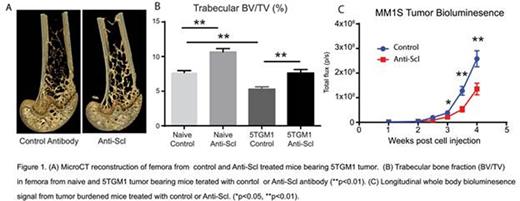Abstract
Multiple myeloma (MM) is a malignancy of plasma cells and is characterized by unrestricted tumor cell growth in bone marrow (BM). MM causes destructive osteolytic lesions causing bone fracture, bone pain, hypercalcaemia, and nerve-compression, resulting from increased bone resorption and suppressed bone formation. Despite the introduction of agents to inhibit bone resorption, such as bisphosphonates, which prevent further bone loss, approaches to preventing osteoblast suppression and repair bone lesions are limited and there are no agents available clinically.
The wnt/β-catenin pathway plays a critical role in the regulation of bone formation. Production of the soluble wnt antagonist dickkopf1 (Dkk1) by MM cells has been implicated in MM inhibition of bone formation. As such, Anti-Dkk1 treatment prevents bone disease in pre-clinical models of MM and is in early clinical development. However, Dkk1 is not expressed by all myeloma cells; hence only a proportion of patients may respond to anti-Dkk1 therapy. Sclerostin (Scl) is a soluble wnt antagonist whose expression, unlike Dkk1, is restricted to osteocytes; therefore Scl targeted agents may have less off target effects. Anti-Sclerostin (Anti-Scl) treatment increased bone formation and bone volume in experimental models of osteoporosis, and increased bone mineral density in phase II osteoporosis clinical trials. However, Anti-Scl treatment effects on myeloma bone disease are unknown. Further, cells of the BM such as osteoblasts have been implicated in the regulation of MM cell survival and growth. Thus, in the present study we explored the potential for Anti-Scl therapy to prevent MM induced bone loss and inhibit MM growth in both murine and human xenograft MM models.
Female C57BLKalwRij mice (n=8) were injected i.v, with 5TGM1/eGFP murine MM cells (1×106) and female SCID/beige mice (n=10) were injected i.v. with MM1S/Luc/eGFP human MM cells (4 × 106). 24 hours later, naïve mice (without tumor cells) or mice bearing MM cells were treated with anti-sclerostin antibody (Anti-Scl) (100mg/kg i.v) or control antibody. Mice were sacrificed at day 21 (MM1S) or day 28 (5TGM1) and the effect of Anti-Scl on bone structure in the femora and vertebrae were determined by microCT analysis. The effect of Anti-Scl on MM burden was determined by bioluminescent imaging (BLI) performed twice weekly from week 1 using a Xenogen IVIS system, whereas MM burden in 5TGM1/eGFP bearing mice was examined by FACS analysis.
Anti-Scl treatment in naïve C57BLKalwRij mice increased trabecular bone volume fraction (BV/TV, 39%, p<0.01, Fig. 1B) in the femur, which was mediated by increases in trabecular thickness (Tb.Th, 42%, p<0.01). Treatment also increased cortical bone volume (22%, p<0.01) in the femur and increased trabecular BV/TV in the vertebra (32%, p<0.01). This demonstrated the potent bone anabolic effect of Anti-Scl independent of myeloma cells. Injection of 5TGM1 cells resulted in a decrease in femoral trabecular BV/TV (30%, p<0.01) through a 30% reduction in trabecular number (TbN) (p<0.01), but no effect on Tb.Th (Figs. 1A and B), whilst also reducing cortical bone volume (BV) by 6% (p<0.05). Vertebrae were also impacted by 5TGM1 tumor growth with a 29% reduction in Tb BV/TV through a 23% reduction in Tb.Th (p<0.01) and also a 15% reduction in cortical BV (p<0.01). Treatment of 5TGM1-bearing mice with Anti-Scl increased trabecular BV/TV (46%, p<0.01) and Tb.Th (30%, p<0.01) to values equivalent to femora of naïve, non-tumor bearing, control mice. Treatment with Anti-Scl also increased cortical BV by 16% (p<0.01), vertebral Tb BV/TV by 29% and cortical BV by 36% in 5TGM1 burdened mice (p<0.01).
Treatment of 5TGM1-bearing mice with Anti-Scl had no effect on the proportion 5TGM1/eGFP cells in the BM or spleen. However Anti-Scl treatment significantly suppressed tumor progression in the MM1S model at 3, 3.5 and 4 weeks post cell injection, as determined by BLI imaging (p=0.02, wk 3; p=0.0019, wk 3.5, and p=0.0068, wk 4, 2-tailed t-tests, Fig. 1C).
These data demonstrate that Anti-Scl antibody treatment can prevent development of myeloma bone disease. Furthermore, Anti-Scl treatment also suppressed tumor growth, supporting the possibility that targeting the BM microenvironment with this agent may slow disease progression. Our findings highlight the potential clinical application of Anti-Scl antibody treatment in patients with MM and other bone destructive cancers.
Kneissel:Novartis Institutes for Biomedical Research, Novartis Pharma AG: Employment. Kramer:Novartis Pharma AG: Employment. Brooks:Spouse works for Boston Biomedical Inc: Employment.
Author notes
Asterisk with author names denotes non-ASH members.


This feature is available to Subscribers Only
Sign In or Create an Account Close Modal